
Montagu Mansions is a street in the City of Westminster, in the Marylebone area of London, England, that is made up entirely of mansions flats and in World War II was one of the locations used by the Special Operations Executive.

Montagu Mansions is a street in the City of Westminster, in the Marylebone area of London, England, that is made up entirely of mansions flats and in World War II was one of the locations used by the Special Operations Executive.
The street runs from York Street in the north to Dorset Street in the south. It is crossed only by Crawford Street.
The street is entirely made up of mansion block flats.
Special Force Headquarters rented offices and accommodation in Montagu Mansions during the Second World War. The Special Operations Executive was located in nearby Baker Street. [1] [2] [3]

The Jubilee line is a London Underground line that runs between Stanmore in suburban north-west London and Stratford in east London, via the Docklands, South Bank and West End. Opened in 1979, it is the newest line on the Underground network, although some sections of track date back to 1932 and some stations to 1879.
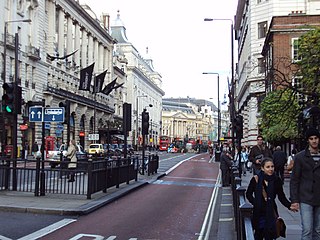
Piccadilly is a road in the City of Westminster, London, England, to the south of Mayfair, between Hyde Park Corner in the west and Piccadilly Circus in the east. It is part of the A4 road that connects central London to Hammersmith, Earl's Court, Heathrow Airport and the M4 motorway westward. St James's is to the south of the eastern section, while the western section is built up only on the northern side. Piccadilly is just under 1 mile (1.6 km) in length, and it is one of the widest and straightest streets in central London.

Cheyne Walk is a historic road in Chelsea, London, England, in the Royal Borough of Kensington and Chelsea. It runs parallel with the River Thames. Before the construction of Chelsea Embankment reduced the width of the Thames here, it fronted the river along its whole length.
Operation Mincemeat was a successful British deception operation of the Second World War to disguise the 1943 Allied invasion of Sicily. Two members of British intelligence obtained the body of Glyndwr Michael, a tramp who died from eating rat poison, dressed him as an officer of the Royal Marines and placed personal items on him identifying him as the fictitious Captain William Martin. Correspondence between two British generals that suggested that the Allies planned to invade Greece and Sardinia, with Sicily as merely the target of a feint, was also placed on the body.

Montagu House was a late 17th-century mansion in Great Russell Street in the Bloomsbury district of London, which became the first home of the British Museum. The first house on the site was destroyed by fire in 1686. The rebuilt house was sold to the British Museum in 1759, and demolished in the 1840s to make way for the present larger building.

Montagu House in Whitehall, Westminster, London, England, was the town house built by John Montagu, 2nd Duke of Montagu (1690–1749), whose country seat was Boughton House in Northamptonshire.

Tower Gardens in North Tottenham is a distinctive semi-circular estate bounded by Lordship Lane and the Roundway. Constructed between 1904 and 1928, it was one of the first municipal "cottage estates" in the world. It is now a conservation area and is featured in the annual London Open City architecture weekend held third weekend in September. Originally known as the White Hart Lane Estate, Tower Gardens was built by the London County Council (LCC) using powers granted to local authorities by the Housing of the Working Classes Act 1900. Samuel Montagu, 1st Baron Swaythling donated £10,000 for the purchase of the land on which it was built. The donation was tied to the rehousing of Jewish workers resident in the Tower Hamlets parish, and required an area of land to be set aside for public gardens: hence the name Tower Gardens. Tower Gardens was also the first LCC estate to be built outside the LCC area.
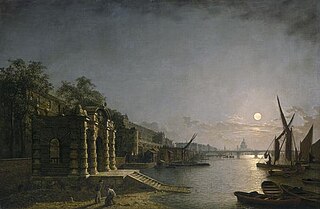
York House was one of a series of grand mansions that formerly stood on the Strand, the principal route from the City of London to the Palace of Westminster.

34 Montagu Square is the address of a London ground floor and basement flat once leased by Beatles member Ringo Starr during the mid-1960s. Its location is 1.3 miles (2.09 km) from the Abbey Road Studios, where The Beatles recorded. Many well-known people have lived at the address, including a British Member of Parliament, Richard-Hanbury Gurney, and the daughter of the Marquess of Sligo, Lady Emily Charlotte Browne. The square was named after Elizabeth Montagu, who was highly regarded by London society in the late 18th century.

Hooper & Co. was a British coachbuilding business for many years based in Westminster London. From 1805 to 1959 it was a notably successful maker, to special order, of luxury carriages, both horse-drawn and motor-powered.

Queen Anne's Mansions was a block of flats in Petty France, Westminster, London, at grid reference TQ296795. In 1873, Henry Alers Hankey acquired a site between St James's Park and St James's Park Underground station. Acting as his own architect, and employing his own labour, he proceeded to erect the first stage of the block. At twelve storeys, later increased to fourteen, it was the loftiest residential building in Britain.

Carlyle Mansions is a block of flats located on Cheyne Walk, in the Chelsea area of London, England. Built in 1886, it was named after Thomas Carlyle, himself a resident of Chelsea for much of his life.
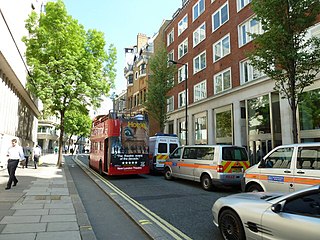
Petty France is a street in the City of Westminster in central London, linking Buckingham Gate with Broadway and Queen Anne's Gate.

York Mansions is one of the seven Victorian blocks of flats on Prince of Wales Drive, London, between Albert Bridge Road and Queenstown Road, in Battersea, in the London borough of Wandsworth. The four-storey building is portered.

The Ossulston Estate is a multi-storey council estate built by the London County Council on Chalton Street in Somers Town between 1927 and 1931. It was unusual at the time both in its inner-city location and in its modernist design, and all the original parts of the estate are now Grade II listed buildings.
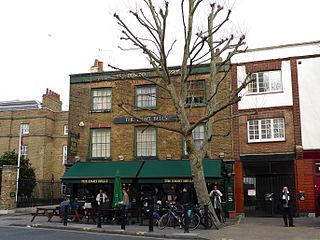
The Eight Bells is a pub in Fulham High Street, close to the northern end of Putney Bridge.

Lissenden Gardens is a small inner urban area in north London in the London Borough of Camden at the very south east of Hampstead Heath.

Grosvenor Gardens House is a Grade II-listed mansion block at 23–47 Grosvenor Gardens, Belgravia, London. Queen Elizabeth The Queen Mother may have been born there in 1900. David Niven was born there in 1910, and William Henry Blackmore killed himself there in 1878. In 2017, the building was the subject of a £132-million High Court trial for damages brought against Christian and Nick Candy by Mark Holyoake, a former friend and business associate who had financed the purchase of the property via a loan from the brothers. The action was unsuccessful, but the course of the trial put the Candys' business practices under an unflattering spotlight.

A House Through Time is a documentary television series made by Twenty Twenty Television for BBC Two. The first series aired in 2018, a second in 2019, a third in 2020, and a fourth in 2021, with each examining the history of a single residential building in an English city. A fifth series, in 2024, features apartment blocks in London and Berlin.
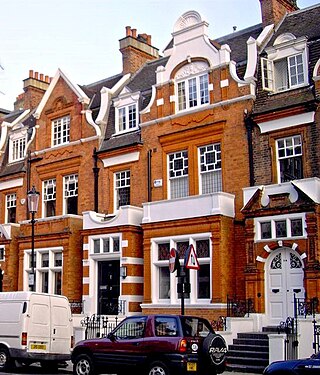
Earl's Court Square is a garden square in Earl's Court, London, England. It was developed from 1872 or 1873 on agricultural land belonging to the Edwardes family. It is primarily made up of stuccoed terraced houses with Italianate dressings but also contains properties in the Jacobean and Second Empire styles as well as a number of purpose built apartment blocks.
![]() Media related to Montagu Mansions at Wikimedia Commons
Media related to Montagu Mansions at Wikimedia Commons
51°31′11.97″N0°9′27.69″W / 51.5199917°N 0.1576917°W